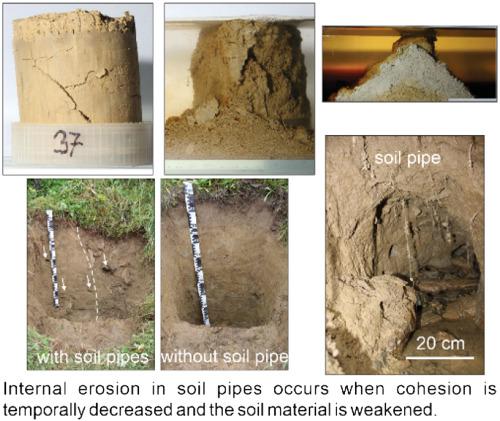当前位置:
X-MOL 学术
›
Earth Surf.Process. Land.
›
论文详情
Our official English website, www.x-mol.net, welcomes your
feedback! (Note: you will need to create a separate account there.)
Sediment detachment in piping‐prone soils: Cohesion sources and potential weakening mechanisms
Earth Surface Processes and Landforms ( IF 2.8 ) Pub Date : 2020-07-16 , DOI: 10.1002/esp.4959 Anita Bernatek‐Jakiel 1 , Jiří Bruthans 2 , Jan Vojtíšek 2 , Mateusz Stolarczyk 1 , Tomasz Zaleski 3
Earth Surface Processes and Landforms ( IF 2.8 ) Pub Date : 2020-07-16 , DOI: 10.1002/esp.4959 Anita Bernatek‐Jakiel 1 , Jiří Bruthans 2 , Jan Vojtíšek 2 , Mateusz Stolarczyk 1 , Tomasz Zaleski 3
Affiliation

|
Soil piping is a widespread land degradation process that may lead to gully formation. However, the processes involved in sediment detachment from soil pipe walls have not been well studied, although their recognition is a crucial step to protect soils from piping erosion. This study aims to recognize the factors affecting cohesion and to identify the mechanisms which are likely to be responsible for the disintegration of soil. The study has been conducted in mid‐altitude mountains under a temperate climate (the Bieszczady Mountains, the Carpathians, SE Poland). The research was based on the detailed field and laboratory analyses of morphology, and the physical and chemical properties of soil profiles with and without soil pipes. Moreover, experiments with flooding the undisturbed soil samples using different solutions (deionized water, ammonium oxalate, dithionate citrate, 35% hydrochloric acid and 30% hydrogen peroxide) were conducted in order to check the role of air slaking, the removal of soil organic carbon (SOC), and Fe and Al oxides on sediment detachment. The obtained results have confirmed that soil pipes develop in quite cohesive soils (silt loams), which allow the formation and maintenance of pipes with a diameter up to 30 cm. Soil cohesion, and thus susceptibility to piping, are impacted by the content of major oxides, soil particle size distribution, biological activity and porosity. The tested soils affected by piping erosion have a lower content of Al2O3 and Fe2O3, and free Fe (Fe(DCB)), lower clay content, higher biological activity (more roots and animal burrows), higher porosity, and more and larger pores than the profile without soil pipes. The experiments have indicated that especially SOC along with Fe and Al oxides are an important cohesion source in the study area. This suggests that the removal of SOC, and Fe and Al oxides may weaken and disintegrate aggregates in soil pipes. Further study of soil leaching and tensile strength will broaden understanding of which chemical processes control where pipes will develop in other cohesive piping‐prone soils. © 2020 John Wiley & Sons, Ltd.
中文翻译:

管道易积土中的泥沙分离:内聚源和潜在的减弱机制
土壤管道运输是一个广泛的土地退化过程,可能导致沟壑形成。然而,尽管对沉积物的认识是保护土壤免受管道侵蚀的关键步骤,但对沉积物从土壤管壁分离的过程尚未进行充分的研究。这项研究旨在识别影响内聚力的因素,并确定可能导致土壤崩解的机制。该研究是在温带气候下的中海拔山区(Bieszczady山脉,喀尔巴阡山脉,波兰东南部)进行的。该研究基于详细的现场和实验室分析,包括形态学以及有无土壤管的土壤剖面的物理和化学性质。此外,还使用不同的溶液(去离子水,进行草酸铵,柠檬酸二硫酯,35%盐酸和30%过氧化氢的处理,以检查空气分解,土壤有机碳(SOC)以及铁和铝氧化物对沉积物分离的作用。获得的结果证实,土壤管在粘性很强的土壤(淤泥壤土)中生长,这允许形成和维护直径最大为30 cm的管。土壤内聚力以及对管道的敏感性受到主要氧化物含量,土壤粒度分布,生物活性和孔隙度的影响。受管道腐蚀影响的被测土壤的铝含量较低 以及铁和铝氧化物对沉积物的分离。获得的结果证实,土壤管在粘性很强的土壤(泥质壤土)中生长,这允许形成和维护直径最大为30 cm的管。土壤内聚力以及对管道的敏感性受到主要氧化物含量,土壤粒度分布,生物活性和孔隙度的影响。受管道腐蚀影响的被测土壤的铝含量较低 以及铁和铝氧化物对沉积物的分离。获得的结果证实,土壤管在粘性很强的土壤(泥质壤土)中生长,这允许形成和维护直径最大为30 cm的管。土壤内聚力以及对管道的敏感性受到主要氧化物含量,土壤粒度分布,生物活性和孔隙度的影响。受管道腐蚀影响的被测土壤的铝含量较低2 O 3和Fe 2 O 3以及游离的Fe(Fe (DCB)),粘土含量较低,生物活性较高(更多的根和动物洞穴),更高的孔隙率以及比没有土壤管的剖面更大和更大的孔隙。实验表明,特别是SOC以及Fe和Al氧化物是研究区域的重要内聚源。这表明去除SOC,Fe和Al氧化物可能会削弱和分解土壤管道中的聚集体。对土壤浸出和抗张强度的进一步研究将拓宽对哪些化学过程控制在其他易发生粘性管道的土壤中管道发育的了解。分级为4 +©2020 John Wiley&Sons,Ltd.
更新日期:2020-07-16
中文翻译:

管道易积土中的泥沙分离:内聚源和潜在的减弱机制
土壤管道运输是一个广泛的土地退化过程,可能导致沟壑形成。然而,尽管对沉积物的认识是保护土壤免受管道侵蚀的关键步骤,但对沉积物从土壤管壁分离的过程尚未进行充分的研究。这项研究旨在识别影响内聚力的因素,并确定可能导致土壤崩解的机制。该研究是在温带气候下的中海拔山区(Bieszczady山脉,喀尔巴阡山脉,波兰东南部)进行的。该研究基于详细的现场和实验室分析,包括形态学以及有无土壤管的土壤剖面的物理和化学性质。此外,还使用不同的溶液(去离子水,进行草酸铵,柠檬酸二硫酯,35%盐酸和30%过氧化氢的处理,以检查空气分解,土壤有机碳(SOC)以及铁和铝氧化物对沉积物分离的作用。获得的结果证实,土壤管在粘性很强的土壤(淤泥壤土)中生长,这允许形成和维护直径最大为30 cm的管。土壤内聚力以及对管道的敏感性受到主要氧化物含量,土壤粒度分布,生物活性和孔隙度的影响。受管道腐蚀影响的被测土壤的铝含量较低 以及铁和铝氧化物对沉积物的分离。获得的结果证实,土壤管在粘性很强的土壤(泥质壤土)中生长,这允许形成和维护直径最大为30 cm的管。土壤内聚力以及对管道的敏感性受到主要氧化物含量,土壤粒度分布,生物活性和孔隙度的影响。受管道腐蚀影响的被测土壤的铝含量较低 以及铁和铝氧化物对沉积物的分离。获得的结果证实,土壤管在粘性很强的土壤(泥质壤土)中生长,这允许形成和维护直径最大为30 cm的管。土壤内聚力以及对管道的敏感性受到主要氧化物含量,土壤粒度分布,生物活性和孔隙度的影响。受管道腐蚀影响的被测土壤的铝含量较低2 O 3和Fe 2 O 3以及游离的Fe(Fe (DCB)),粘土含量较低,生物活性较高(更多的根和动物洞穴),更高的孔隙率以及比没有土壤管的剖面更大和更大的孔隙。实验表明,特别是SOC以及Fe和Al氧化物是研究区域的重要内聚源。这表明去除SOC,Fe和Al氧化物可能会削弱和分解土壤管道中的聚集体。对土壤浸出和抗张强度的进一步研究将拓宽对哪些化学过程控制在其他易发生粘性管道的土壤中管道发育的了解。分级为4 +©2020 John Wiley&Sons,Ltd.











































 京公网安备 11010802027423号
京公网安备 11010802027423号